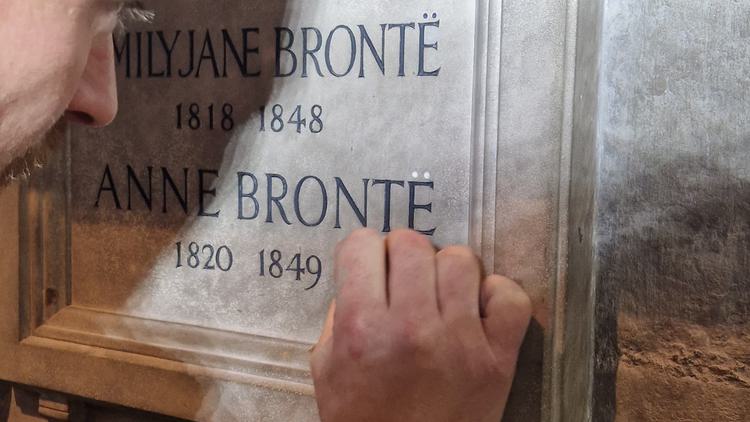
News Story
The Brontë memorial in Westminster Abbey has been amended to include the diaereses (dots) over the ‘e’ of the names of Charlotte, Emily, and Anne Brontë, following an approach from journalist and Brontë historian Sharon Wright. The diaereses have been missing from the memorial since its installation 85 years ago.
The Dean of Westminster, The Very Reverend Dr David Hoyle, agreed with Sharon, Editor of the Brontë Society Gazette, that they should be added after she alerted him earlier this year that they were missing. Sharon was visiting the Abbey to research a new book about the Brontës when she noticed they weren't on the memorial.
The work to put the diaereses on has been completed by an Abbey stonemason tapping the dots in and an Abbey conservator painting them. Meanwhile, Sharon has been endeavouring to unravel the mystery of their omission in 1939.

The Brontë memorial is a rectangular tablet of Huddlestone stone, measuring 600mm x 600mm, in Poets’ Corner near other famous writers - including Jane Austen, William Shakespeare, and Charles Dickens. It was installed on 8 October 1939, soon after the outbreak of the Second World War, having been sponsored by the Brontë Society.
A letter to The Times about the memorial from Paul de Labilliere, then Dean of Westminster, dated 2 November 1939, records ‘I should greatly wish that its completion should be marked by a ceremonial unveiling but in these times anything of that sort is out of the question’. By the time there was a formal ceremony with the Brontë Society, on 19 July 1947, the nation was re-building itself after the war, and the missing diaereses appear not to have been mentioned.
The two dots, which are fairly rare in English, have a fascinating role in the evolution of the famous name and indicate the division of a word into two syllables. The world-famous Brontë name evolved from their father Patrick’s Irish surname of Prunty or Brunty when he entered St. John's College, Cambridge, in 1802.
A letter in the Abbey archive from Donald Hopewell, President of the Brontë Society, to the Dean of Westminster, dated 1 May 1939, clearly gives instructions for the wording of the memorial, which includes the diaereses. But the puzzle of the misspelled Brontë tablet remains.
Sharon Wright said: “As a journalist, I always ask questions. As soon as I saw the tablet I wanted to know why the famous name was spelled incorrectly. Also, why no-one had ever pointed this out before. I am immensely proud that the correct, unique and immortal name of Charlotte, Emily and Anne is finally complete in Poets’ Corner. It's a Brontë story with a happy and timely ending.”
The Very Reverend Dr David Hoyle, The Dean of Westminster said: “I'm grateful to have this omission pointed out and now put right. Memory is not a locked cupboard, but an active thing and the Brontë Society has given us a glimpse of their commitment to a lively remembering.”
Rebecca Yorke, Director of the Brontë Society, said: “We're absolutely thrilled with this outcome and are very grateful to the Dean of Westminster and his colleagues at the Abbey for their positive response to Sharon’s enquiries. As the Brontës and their work are loved and respected all over the world, it’s entirely appropriate that their name is spelled correctly on their memorial. I’m sure that everyone at the Brontë Society and the Brontë Parsonage Museum, as well as Brontë enthusiasts across the world, will be very excited to learn about this new episode in the enduring story of Charlotte, Emily and Anne.”

